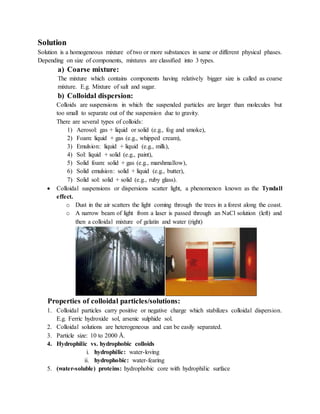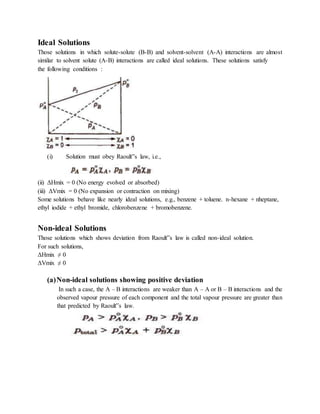solutions
- 1. Solution Solution is a homogeneous mixture of two or more substances in same or different physical phases. Depending on size of components, mixtures are classified into 3 types. a) Coarse mixture: The mixture which contains components having relatively bigger size is called as coarse mixture. E.g. Mixture of salt and sugar. b) Colloidal dispersion: Colloids are suspensions in which the suspended particles are larger than molecules but too small to separate out of the suspension due to gravity. There are several types of colloids: 1) Aerosol: gas + liquid or solid (e.g., fog and smoke), 2) Foam: liquid + gas (e.g., whipped cream), 3) Emulsion: liquid + liquid (e.g., milk), 4) Sol: liquid + solid (e.g., paint), 5) Solid foam: solid + gas (e.g., marshmallow), 6) Solid emulsion: solid + liquid (e.g., butter), 7) Solid sol: solid + solid (e.g., ruby glass). Colloidal suspensions or dispersions scatter light, a phenomenon known as the Tyndall effect. o Dust in the air scatters the light coming through the trees in a forest along the coast. o A narrow beam of light from a laser is passed through an NaCl solution (left) and then a colloidal mixture of gelatin and water (right) Properties of colloidal particles/solutions: 1. Colloidal particles carry positive or negative charge which stabilizes colloidal dispersion. E.g. Ferric hydroxide sol, arsenic sulphide sol. 2. Colloidal solutions are heterogeneous and can be easily separated. 3. Particle size: 10 to 2000 Å. 4. Hydrophilic vs. hydrophobic colloids i. hydrophilic: water-loving ii. hydrophobic: water-fearing 5. (water-soluble) proteins: hydrophobic core with hydrophilic surface
- 2. 6. detergents: hydrophobic tail with hydrophilic head c) True solution: It is defined as the homogeneous mixture of two or more substances, the composition of which is not fixed and may be varied within certain limits. Properties of true solution: 1) Size of particles dissolved in the solvent are very small of the order of 10 cm 2) It is homogenous. 3) It cannot be separated into components by simple mechanical method. Composition of solution a) Solute: The component which constitutes smaller part of solution is called as solute. b) Solvent: The component which constitutes larger part of solution is called as solvent. Homogeneous solution: The solution whose composition is uniform throughout the body of the solution is called as homogeneous solution. Formation/Preparation: The homogeneous solution is formed due to force of attraction between the molecules or particles of solute and solvent. Heterogeneous solution: It is defined as the mixture of two or more phases. Solvation: It is defined as the process of interaction of solvent molecules with solute particles to form aggregates. When water is used as solvent, it is called as hydration. Binary solution On the basis of number of components a solution of two components is called binary solution.
- 3. Classification of Solutions (A) Following types of solutions are seen on the basis of physical state of solute and solvent. • Intermolecular forces become rearranged in the process of making solutions with condensed Phases. Examples of Solution: (B) Depending upon the amount of solute dissolved in a solvent we have the following types of solutions: Saturated solution A solution containing the maximum amount of solute that will dissolve under a given set of pressure and temperature conditions. Saturated solutions are at dynamic equilibrium with any excess undissolved solute present. Solute particles dissolve and recrystallize at equal rates. Unsaturated solution A solution containing less than the maximum amount of solute that will dissolve under a given set of conditions. (more solute can dissolve) Supersaturated solution A solution that has been prepared at an elevated temperature and then slowly cooled. It contains more than the usual maximum amount of solution dissolved. A supersaturated solution is very unstable and agitation (stirring, pouring, etc.) or the addition of a “seed crystal’ will cause all excess solute to crystallize out of solution leaving the remaining solvent saturated. Concentration of Solutions The concentration of a solution is defined as the relative amount of solute present in a solution. On the basis of concentration of solution there are two types of solutions. (i) Dilute solution (ii) Concentrated solution Concentration Units Molarity (M) 1. No. of moles of solute per liter of solution;
- 4. 2. Is temperature dependent. 3. The liquid solvent can expand and contract with changes in temperature. 4.Thus, not a constant ratio of solute solvent particles . Mass percent (weight percent) It is the percent by mass of the solute in the solution. Mole fraction (χ) 1. It is the ratio of the number of moles of a given component to the total number of moles of present. Molality (m) 1. No. of moles of solute per kilogram of solvent; 2. NOT temperature dependent. 3. Represents a ratio of solute solvent molecules at all times. Molality does not vary with temperature. Note: converting between molarity (M) and molality (m) requires density.
- 5. Parts per million (ppm) 1. It can be expressed as the number of mg of solute per kilogram of solution. 2. If the density of the solution is 1g/ml, then 1 ppm = 1 mg solute per liter of solution. Parts per billion (ppb) 1. It can be expressed as the number of μg of solute per kilogram of solution. 2. If the density of the solution is 1g/ml, then 1 ppb = 1 μg solute per liter of solution. Solubility The maximum amount of a solute that can be dissolved in a given amount of solvent (generally 100 g) at a given temperature is termed as its solubility at that temperature. The solubility of a solute in a liquid depends upon the following factors: (i) Nature of the solute (ii) Nature of the solvent (iii) Temperature of the solution (iv)Pressure (in case of gases)
- 6. FACTORS AFFECTING SOLUBILITY Molecular Structure: 1. Fat soluble vitamins, (A,D,E,K) –nonpolar (can be stored in fatty body tissues) 2. Water soluble vitamins, (B&C) –polar (are not stored, wash away and must be consumed 3. regularly) 4. Hydrophobic— water fearing (nonpolar) 5. Hydrophilic – water loving (polar) Nature of the solute and solvent 1. The nature of the solute and solvent “like dissolve like” is a general rule. • polar or ionic substances tend to be more compatible with other polar substances. • nonpolar substances tend to be compatible with other nonpolar substances and less miscible 2. with polar substances. 3. ex. NaCl is more soluble in water than in ether, hexane or benzene. 4. pentane is slightly soluble in water but is soluble in ether or benzene. 5. Solution formation between polar substance. 6. NaCl dissolves in water 7. NaCl(crystal)Na+(aq) + Cl-(aq) The Effect of Increasing Pressure 1. The solubility of a gas increases with increasing pressure. 2. Increasing pressure has very little effect on the solubility of liquids and solids.
- 7. Henry’s Law 1. The amount of a gas dissolved in a solution is directly proportional to the pressure of the gas above the solution. 2. Henry’s Law is obeyed best for dilute solutions of gases that don’t dissociate or react with the solvent. Henry’s Law: C = kP P = partial pressure of the gaseous solute above the solution k = constant (depends on the solution) C = concentration of dissolved gas Application of henry’s law • Carbonated beverages are bottled under PCO2> 1 atm. • As the bottle is opened, PCO2 ↓ � solubility of CO2 ↓ � escape of bubbles of CO2from solution The Effect of Increasing Temperature 1. The amount of solute that will dissolve usually increases with increasing temperature since most solution formation is endothermic. 2. Solubility generally increases with temperature if the solution process is endothermic (ΔHsoln > 0). 3. Solubility generally decreases with temperature if the solution process is exothermic (ΔHsoln < 0). 4. Potassium hydroxide, sodium hydroxide and sodium sulfate are three compounds that become less soluble as the temperature rises. This can be explained by LeChatelier’s Principle. 5. The solubility of a gas in water always decreases with increasing temperature. 6. Sugar dissolves better in warm water than in cold water. ↑T� ↑ solubility of solids in liquids 7. Sometimes solubility ↓ as T ↑ (e.g., Ce2(SO4)3). 8. Carbonated beverages go flat as they get warm. � Gases: ↑ T of liquid � ↓ solubility of gas in liquid. 9. Environmental application: ↑ T of lakes� ↓ solubility CO2 and O2 in water� fish suffocate
- 8. Raoult’s Law The Raoult‟s law states “For a solution of two volatile liquids, the vapour pressure of each liquid in the solution is less than the respective vapour pressure of the pure liquids and the equilibrium partial vapour pressure of the liquid is directly proportional to its mole fraction. For a solution containing two liquids A and B, the partial vapour pressure of liquid A is The proportionality constant is obtained by considering the pure liquid when χA = 1 then k = P°A, the vapour pressure of pure liquid, hence
- 9. Ideal Solutions Those solutions in which solute-solute (B-B) and solvent-solvent (A-A) interactions are almost similar to solvent solute (A-B) interactions are called ideal solutions. These solutions satisfy the following conditions : (i) Solution must obey Raoult‟s law, i.e., (ii) ΔHmix = 0 (No energy evolved or absorbed) (iii) ΔVmix = 0 (No expansion or contraction on mixing) Some solutions behave like nearly ideal solutions, e.g., benzene + toluene. n-hexane + nheptane, ethyl iodide + ethyl bromide, chlorobenzene + bromobenzene. Non-ideal Solutions Those solutions which shows deviation from Raoult‟s law is called non-ideal solution. For such solutions, ΔHmix ≠ 0 ΔVmix ≠ 0 (a)Non-ideal solutions showing positive deviation In such a case, the A – B interactions are weaker than A – A or B – B interactions and the observed vapour pressure of each component and the total vapour pressure are greater than that predicted by Raoult‟s law.
- 10. (b) Non-ideal solution showing negative deviation In such a case, the A – B interactions are stronger than A – A or B – B interactions and the observed vapour pressure of each component and the total vapour pressure are lesser than that predicted by Raoult‟s law.
- 11. When a solution does not obey Raoult’s law over the entire range of Solutions concentration, then it is called non-ideal solution. The vapour pressure of such a solution is either higher or lower than that predicted by Raoult’s law (equation 2.16). If it is higher, the solution exhibits positive deviation and if it is lower, it exhibits negtive deviation from Raoult’s law. The plots of vapour pressure as a function of mole fractions for such solutions are shown in Fig. Fig. the vapour pressure of two components systems as a function of composition (a) A solution that shows positive deviation (b) A solution that shows negative deviation Colligative properties: The properties of solutions that depend only on the number of solute particles in solution and not on the nature of the solute particle are called as Colligative properties. Colligative properties are used to determine molar masses of non-electrolyte solutes. The relations derived by measuring colligative properties hold good for dilute solutions, with concentration less than or equal to 0.2M. Four Colligative Properties 1. Lowering of vapour pressure of solvent in solution 2. Elevation of boiling point of solvent in solution 3. Depression of freezing point of solvent in solution 4. Osmotic pressure










